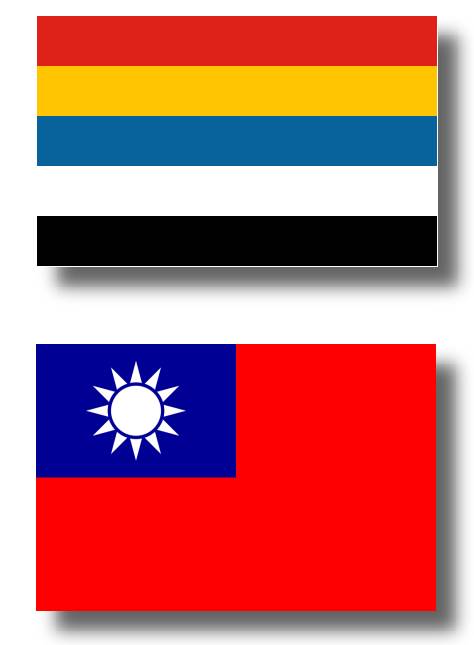
Top flag (1912–28), Bottom flag (1928–49)
The Republic of China (ROC) was established January 1, in 1912 following the Xinhai Revolution and the Wuchang Uprising, replacing the Qing Dynasty and ending over two thousand years of imperial rule in China. There was industrialization and modernization, but also conflict between the Nationalist government in Nanjing, the Communist Party of China, remnant warlords, and the Empire of Japan.
From its founding until 1949 the ROC was based on mainland China where authority waxed and waned. The main eras during this period:
The Republic of China was preceded by the last imperial dynasty of China, the Qing dynasty, and its end was marked by the end of the Chinese Civil War, in which the losing Kuomintang retreated to the island of Taiwan, while the victorious Communist Party of China proclaimed the People's Republic of China on the Mainland.
Kuomintang (1911-1949)
Often translated as the Nationalist Party of China or Chinese Nationalist Party was instrumental in the overthrown of the Qing dynasty. It was co-founded by Sun Yat-sen and Yuan Shikai shortly after 1911. In 1925, the Kuomintang started establishing a rival government in the southern city of Guangzhou. It was the ruling party in mainland China from 1928 until its retreat to Taiwan in 1949 after being defeated by the Communist Party of China (CPC) during the Chinese Civil War.Sun Yat-sen (1912)
First president and founding father of the Republic of China. Sun Yat-sen, served only briefly. His party, then led by Song Jiaoren, won a parliamentary election held in December 1912. Premier of the Kuomintang of China 1919–1925.
Yuan Shikai ( -1916)
However the army led by President Yuan Shikai retained control of the national government in Beijing. After Yuan's death in 1916, local military leaders, or warlords, asserted autonomy.
Chiang Kai-shek (1928-1931), Nanjing
General Chiang Kai-shek, who became Kuomintang (KMT) leader after Sun's death, started his military Northern Expedition campaign in order to overthrow the central government in Beijing. In 1928 Chiang established a new Nationalist Government of China in Nanjing. Chiang Kai-shek was socially conservative, promoting traditional Chinese culture in the New Life Movement and rejecting both western democracy and Sun's nationalist democratic socialism in favour of an authoritarian government. Unable to maintain Sun's good relations with the Communists, he purged them in a massacre at Shanghai and repression of uprisings at Guangzhou and elsewhere.
Japanese invasion of China (1937-1945)
Nation-building took a backseat to war when the Imperial Japanese military launched a full-scale invasion of China in 1937. The Japanese was driven back in Yunnan during a May–June 1944 offensive, but otherwise military results were disappointing.
End of WWII 1945
With the Japanese unconditional surrender in 1945, the Allies had finally achieved total victory. The Empire of Japan surrendered control of Taiwan and its island groups to the Allied Forces. Taiwan was placed under the Republic of China (ROC) administrative control.
The Cold War between the U.S. and Soviet Union led to renewed fighting between the KMT and the communists.
Communist takeover in 1949In 1949 The Communist Party of China took over all of mainland China and founded the People's Republic of China (PROC) in Beijing.
ROC government retreated to Taiwan
A